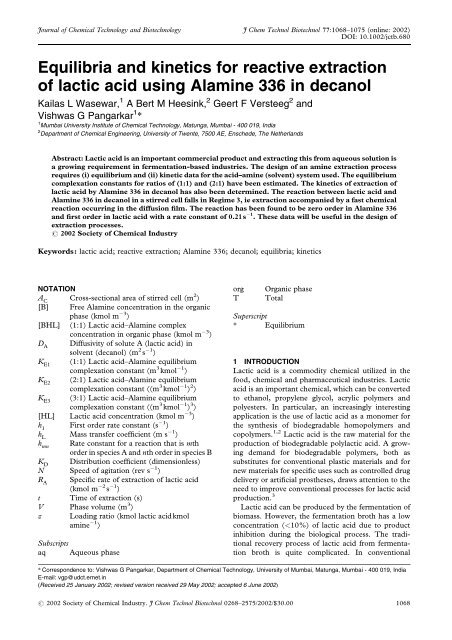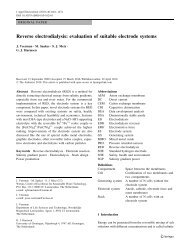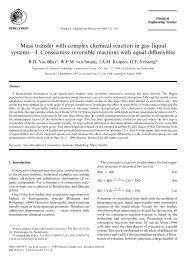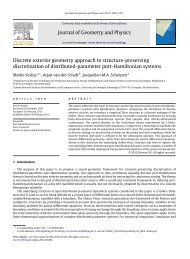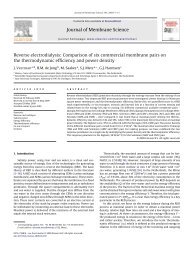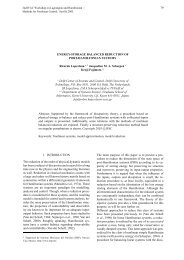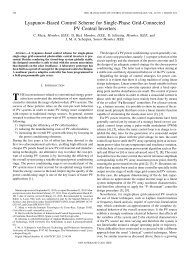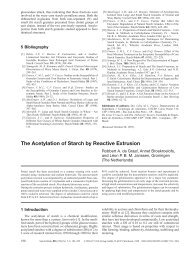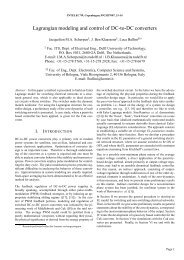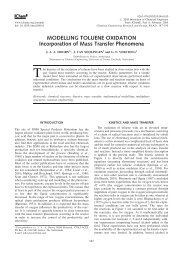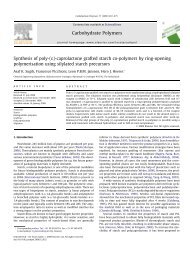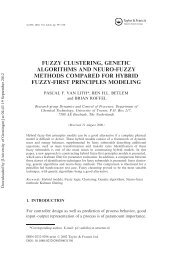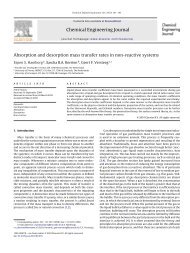Equilibria and kinetics for reactive extraction of lactic acid ... - ITM
Equilibria and kinetics for reactive extraction of lactic acid ... - ITM
Equilibria and kinetics for reactive extraction of lactic acid ... - ITM
Create successful ePaper yourself
Turn your PDF publications into a flip-book with our unique Google optimized e-Paper software.
Journal <strong>of</strong> Chemical Technology <strong>and</strong>Biotechnology J Chem Technol Biotechnol 77:1068±1075 (online: 2002)DOI: 10.1002/jctb.680<strong>Equilibria</strong> <strong>and</strong> <strong>kinetics</strong> <strong>for</strong> <strong>reactive</strong> <strong>extraction</strong><strong>of</strong> <strong>lactic</strong> <strong>acid</strong> using Alamine 336 in decanolKailas L Wasewar, 1 A Bert M Heesink, 2 Geert F Versteeg 2 <strong>and</strong>Vishwas G Pangarkar 1 *1 Mumbai University Institute <strong>of</strong> Chemical Technology, Matunga, Mumbai - 400 019, India2 Department <strong>of</strong> Chemical Engineering, University <strong>of</strong> Twente, 7500 AE, Enschede, The Netherl<strong>and</strong>sAbstract: Lactic <strong>acid</strong> is an important commercial product <strong>and</strong> extracting this from aqueous solution isa growing requirement in fermentation-based industries. The design <strong>of</strong> an amine <strong>extraction</strong> processrequires (i) equilibrium <strong>and</strong> (ii) kinetic data <strong>for</strong> the <strong>acid</strong>±amine (solvent) system used. The equilibriumcomplexation constants <strong>for</strong> ratios <strong>of</strong> (1:1) <strong>and</strong> (2:1) have been estimated. The <strong>kinetics</strong> <strong>of</strong> <strong>extraction</strong> <strong>of</strong><strong>lactic</strong> <strong>acid</strong> by Alamine 336 in decanol has also been determined. The reaction between <strong>lactic</strong> <strong>acid</strong> <strong>and</strong>Alamine 336 in decanol in a stirred cell falls in Regime 3, ie <strong>extraction</strong> accompanied by a fast chemicalreaction occurring in the diffusion ®lm. The reaction has been found to be zero order in Alamine 336<strong>and</strong> ®rst order in <strong>lactic</strong> <strong>acid</strong> with a rate constant <strong>of</strong> 0.21s 1 . These data will be useful in the design <strong>of</strong><strong>extraction</strong> processes.# 2002 Society <strong>of</strong> Chemical IndustryKeywords: <strong>lactic</strong> <strong>acid</strong>; <strong>reactive</strong> <strong>extraction</strong>; Alamine 336; decanol; equilibria; <strong>kinetics</strong>NOTATIONA CCross-sectional area <strong>of</strong> stirred cell (m 2 )[B] Free Alamine concentration in the organicphase (kmol m 3 )[BHL] (1:1) Lactic <strong>acid</strong>±Alamine complexconcentration in organic phase (kmol m 3 )D ADiffusivity <strong>of</strong> solute A (<strong>lactic</strong> <strong>acid</strong>) insolvent (decanol) (m 2 s 1 )K E1(1:1) Lactic <strong>acid</strong>±Alamine equilibriumcomplexation constant (m 3 kmol1 )K E2(2:1) Lactic <strong>acid</strong>±Alamine equilibriumcomplexation constant ((m 3 kmol1 ) 2 )K E3(3:1) Lactic <strong>acid</strong>±Alamine equilibriumcomplexation constant ((m 3 kmol1 ) 3 )[HL] Lactic <strong>acid</strong> concentration (kmol m 3 )k 1First order rate constant (s 1 )k LMass transfer coef®cient (m s 1 )k mnRate constant <strong>for</strong> a reaction that is mthorder in species A <strong>and</strong> nth order in species BK DDistribution coef®cient (dimensionless)N Speed <strong>of</strong> agitation (rev s 1 )R ASpeci®c rate <strong>of</strong> <strong>extraction</strong> <strong>of</strong> <strong>lactic</strong> <strong>acid</strong>(kmol m 2 s 1 )t Time <strong>of</strong> <strong>extraction</strong> (s)V Phase volume (m 3 )z Loading ratio (kmol <strong>lactic</strong> <strong>acid</strong>kmolamine 1 )Subscriptsaq Aqueous phaseorgTOrganic phaseTotalSuperscript* Equilibrium1 INTRODUCTIONLactic <strong>acid</strong> is a commodity chemical utilized in thefood, chemical <strong>and</strong> pharmaceutical industries. Lactic<strong>acid</strong> is an important chemical, which can be convertedto ethanol, propylene glycol, acrylic polymers <strong>and</strong>polyesters. In particular, an increasingly interestingapplication is the use <strong>of</strong> <strong>lactic</strong> <strong>acid</strong> as a monomer <strong>for</strong>the synthesis <strong>of</strong> biodegradable homopolymers <strong>and</strong>copolymers. 1,2 Lactic <strong>acid</strong> is the raw material <strong>for</strong> theproduction <strong>of</strong> biodegradable poly<strong>lactic</strong> <strong>acid</strong>. A growingdem<strong>and</strong> <strong>for</strong> biodegradable polymers, both assubstitutes <strong>for</strong> conventional plastic materials <strong>and</strong> <strong>for</strong>new materials <strong>for</strong> speci®c uses such as controlled drugdelivery or arti®cial prostheses, draws attention to theneed to improve conventional processes <strong>for</strong> <strong>lactic</strong> <strong>acid</strong>production. 3Lactic <strong>acid</strong> can be produced by the fermentation <strong>of</strong>biomass. However, the fermentation broth has a lowconcentration (
Reactive <strong>extraction</strong> <strong>of</strong> <strong>lactic</strong> <strong>acid</strong>processes, <strong>lactic</strong> <strong>acid</strong> has been recovered from thefermentation broth by precipitation <strong>of</strong> calcium lactatewith calcium hydroxide. In this, the separation <strong>and</strong>®nal puri®cation stages account <strong>for</strong> up to 50% <strong>of</strong> theproduction costs. 4,5 Thus, this method <strong>of</strong> recovery isexpensive 6,7 <strong>and</strong> unfriendly to the environment as itconsumes lime <strong>and</strong> sulfuric <strong>acid</strong> <strong>and</strong> also produces alarge quantity <strong>of</strong> calcium sulfate sludge as solid waste. 6Allowing accumulation <strong>of</strong> <strong>lactic</strong> <strong>acid</strong> product infermentation broth inhibits further product <strong>for</strong>mation.Reactor productivities are low <strong>and</strong> the products areobtained in a dilute <strong>for</strong>m. The effects <strong>of</strong> end productinhibition can be reduced by in-situ removal <strong>of</strong> <strong>lactic</strong><strong>acid</strong> from fermentation broth by several methods.A number <strong>of</strong> processes <strong>for</strong> <strong>lactic</strong> <strong>acid</strong> recovery fromfermentation broth without precipitation have beenstudied: solvent <strong>extraction</strong>, 8±15 membrane bioreactor,16,17 liquid surfactant membrane <strong>extraction</strong>, 18,19adsorption, 20 direct distillation, 21 electrodialysis, 22±24chromatographic methods, 15 ultra®ltration, 15 reverseosmosis, 15,25 drying, 15 etc.Reactive <strong>extraction</strong> with a speci®ed extractant givinga higher distribution coef®cient has been proposed as apromising technique <strong>for</strong> the recovery <strong>of</strong> carboxylic <strong>and</strong>hydroxycarboxylic <strong>acid</strong>s. 8,26 Solvent <strong>extraction</strong> withtertiary amines has been widely used to recover/fractionate metals such as uranium, iron, cobalt, etcfrom aqueous solutions. 27 Long chain tertiary amineswere used commercially <strong>for</strong> recovery <strong>of</strong> ethanoic <strong>acid</strong>from dilute aqueous streams. 14,28 Tertiary amines<strong>of</strong>fer advantages over other extractants, on thegrounds <strong>of</strong> lower cost <strong>and</strong> generally higher equilibriumdistribution coef®cients (K D). 29 Tertiary amines werefound to be effective <strong>for</strong> extracting <strong>lactic</strong> <strong>acid</strong>, <strong>and</strong>alcohols were among the best diluents, with theadditional advantage that a <strong>lactic</strong> <strong>acid</strong> ester could beproduced after the <strong>extraction</strong> process was completed.30,31 Alamine 336 (mixture <strong>of</strong> C 8,C 9<strong>and</strong> C 10tertiary amines) yields a good combination <strong>of</strong> high K D,low solubility in water <strong>and</strong> good regenerability.The design <strong>of</strong> an amine <strong>extraction</strong> process requires(i) equilibrium <strong>and</strong> (ii) kinetic data <strong>for</strong> the <strong>acid</strong>±amine(solvent) system used. However, little in<strong>for</strong>mation onthe equilibria <strong>and</strong> no in<strong>for</strong>mation pertaining to <strong>kinetics</strong>are available. In view <strong>of</strong> this it was thought desirable toobtain the equilibria <strong>and</strong> <strong>kinetics</strong> <strong>for</strong> the <strong>extraction</strong> <strong>of</strong><strong>lactic</strong> <strong>acid</strong> by Alamine 336 (a tertiary amine, withaliphatic chains <strong>of</strong> 8±10 carbon groups) dissolved indecanol, as diluent.range (0.005±1.5kmol m 3 ) <strong>of</strong> <strong>lactic</strong> <strong>acid</strong> concentrationwas used.The <strong>reactive</strong> component was Alamine 336 (straightchain tertiary amine containing C 8±C 10alkyl groups(Henkel Corp, USA)) with decanol as diluent.Alamine was used as supplied.2.2 Methods2.2.1 <strong>Equilibria</strong>All experiments were carried out at room temperature<strong>of</strong> 25°C. Known volumes <strong>of</strong> aqueous (different concentrations<strong>of</strong> <strong>lactic</strong> <strong>acid</strong>) <strong>and</strong> organic phases (30cm 3each) (both pure decanol <strong>and</strong> decanol containingdifferent concentrations <strong>of</strong> Alamine 336) <strong>of</strong> knownconcentrations were equilibrated in a temperaturecontrolledshaker bath <strong>for</strong> 24h. The two phases wereallowed to settle <strong>for</strong> at least 30min, which wassuf®cient time <strong>for</strong> a complete phase separation. 32 Todetermine the concentration <strong>of</strong> <strong>lactic</strong> <strong>acid</strong>, the aqueousphase was titrated with NaOH using phenolphthaleinas indicator. The <strong>acid</strong> concentrations in the organicphase were calculated by mass balance.2.2.2 KineticsA stirred cell (Fig 1) <strong>of</strong> 0.07m in diameter <strong>and</strong> 0.1mheight, with a ¯at bottom was used <strong>for</strong> the <strong>kinetics</strong>tudies. 33 A 100cm 3 sample <strong>of</strong> an aqueous solution <strong>of</strong><strong>lactic</strong> <strong>acid</strong> <strong>of</strong> known concentration was ®rst placed inthe vessel. The position <strong>of</strong> the four-blade paddle(0.058m in diameter <strong>and</strong> 0.01m in width) doublestirrer was adjusted to 0.01m below <strong>and</strong> above theinterface. A ®xed volume (100cm 3 ) <strong>of</strong> the organicextractant mixture was then added, <strong>and</strong> the mixturewas stirred. Using <strong>acid</strong>±base titration with NaOH <strong>and</strong>phenolphthalein as indicator, the <strong>acid</strong> concentration inthe aqueous phase was determined periodically. Theconcentration <strong>of</strong> <strong>lactic</strong> <strong>acid</strong> in the organic phase wasdetermined by mass balance.The reproducibility was checked by carrying out2 MATERIALS AND METHODS2.1 MaterialsAll the chemicals used (<strong>lactic</strong> <strong>acid</strong>, decanol, sodiumhydroxide) were <strong>of</strong> reagent grade <strong>and</strong> were usedwithout pretreatment. All solutions <strong>of</strong> <strong>lactic</strong> <strong>acid</strong> wereprepared by dissolving <strong>lactic</strong> <strong>acid</strong> <strong>of</strong> analytical purity indistilled water. In practical situations <strong>of</strong> <strong>acid</strong> recoveryfrom fermentation broths, the <strong>acid</strong> concentrations arenot expected to be high. Hence, a low concentrationFigure 1. Stirred cell used <strong>for</strong> kinetic study.J Chem Technol Biotechnol 77:1068±1075 (online: 2002) 1069
KL Wasewar et alTable 1. Procedure <strong>for</strong> discerning reaction mechanism: stirred cellRegimeEffect on the speci®c rate <strong>of</strong> absorption (kmol m 2 s 1 )[A*] [B o] Speed <strong>of</strong> agitation Volume <strong>of</strong> liquid (B phase)1 a [A*] m a [B o] n None a volume2 a [A*] None Increases with increase in the speed <strong>of</strong> stirring None3 a [A*] (m‡1)2 a [B o] n/2 None None4None a a [B o] Increases with increase in the speed <strong>of</strong> stirring in the same manneras in Regime 2Nonea Provided that [B o]z[A*].Reproduced from Ref 33 with permission from John Wiley & Sons.duplicate experiments in some selected cases. Theresults were found to be reproducible within 5%.2.3 Theory <strong>of</strong> <strong>extraction</strong> accompanied by achemical reactionDoraiswamy <strong>and</strong> Sharma (1984) have given anexhaustive discussion on the theory <strong>of</strong> <strong>extraction</strong>accompanied by a chemical reaction. 33 Four regimes<strong>of</strong> <strong>extraction</strong> accompanied by reaction have beenidenti®ed depending upon the physico-chemical <strong>and</strong>hydrodynamic parameters. When the reaction isreversible the solute has a ®nite equilibrium concentrationin the bulk <strong>and</strong> the driving <strong>for</strong>ce needs to bemodi®ed by incorporating the same. The <strong>extraction</strong>involves the partitioning <strong>of</strong> the solute available in theaqueous phase to the organic phase:A aq ! A orgSolute A present in the aqueous phase combineswith the organic reactant (amine) B according toA ‡ zB , ComplexTable 1 gives the guidelines <strong>for</strong> discerning themechanism. The hydrodynamic factors (as signi®ed bythe speed <strong>of</strong> agitation in a stirred cell) are unimportantin Regimes 1 <strong>and</strong> 3 whereas they do affect the rate <strong>of</strong><strong>extraction</strong> in Regimes 2 <strong>and</strong> 4. The expressions <strong>for</strong> therate <strong>of</strong> <strong>extraction</strong> <strong>for</strong> various regimes are given byDoraiswamy <strong>and</strong> Sharma. 33 The expression <strong>for</strong>Regime 3, <strong>extraction</strong> accompanied by a fast generalorder chemical reaction occurring in the diffusion ®lm,isrR A ˆ‰A * Š2m ‡ 1 D Ak mn ‰A * Š m1 ‰B 0 Š n…1†<strong>extraction</strong>. The pH was measured <strong>for</strong> various concentrations<strong>of</strong> <strong>lactic</strong> <strong>acid</strong> <strong>and</strong> the following correlationhas been obtained <strong>for</strong> the above range <strong>of</strong> pH values:pH ˆ 1:90:26 ln‰HLŠThe physical equilibrium distribution isotherm wasmeasured at 25°C in decanol. The results are shown inFig 2. The regression equation <strong>for</strong> physical equilibriaobtained by a statistical analysis <strong>of</strong> the equilibriumdata is:‰HLŠ * org ˆ 0:13‰HLŠ aq0:05‰HLŠ 2 aq…2†For a low range <strong>of</strong> <strong>lactic</strong> <strong>acid</strong> concentration there is alinear relationship between <strong>lactic</strong> <strong>acid</strong> concentration inthe two phases, <strong>and</strong> a parabolic relationship <strong>for</strong> higherconcentrations. It may be argued that <strong>for</strong> low concentrations<strong>of</strong> <strong>lactic</strong> <strong>acid</strong> a Henry's law type isotherm isvalid, whereas at higher concentrations non-idealbehavior can prevail, causing the deviation fromHenry's law. The chemical equilibrium distributionisotherms were measured at 25°C <strong>for</strong> Alamine 336concentrations <strong>of</strong> 20%, 30% <strong>and</strong> 40% (v/v) indecanol. The chemical equilibrium isotherms areshown in Fig 3. It was observed that equilibriumconcentration in the organic phase increased withincreases in Alamine 336 concentration. This showsthat the <strong>extraction</strong> ef®ciency increases with increasing<strong>lactic</strong> <strong>acid</strong> concentrations. San-Martin et al 1992, have3 RESULTS AND DISCUSSION3.1 Extraction equilibriaExperiments were carried out to describe the physical<strong>and</strong> chemical equilibria <strong>for</strong> <strong>lactic</strong> <strong>acid</strong>. The pHchanges with the progress <strong>of</strong> <strong>extraction</strong> <strong>of</strong> <strong>lactic</strong> <strong>acid</strong>.The range <strong>of</strong> pH used <strong>for</strong> <strong>extraction</strong> experiments was1.8±3.4. Equilibrium pH is always higher than initialpH <strong>and</strong> its value depends on the extent <strong>of</strong> <strong>lactic</strong> <strong>acid</strong>Figure 2. Physical equilibria <strong>for</strong> <strong>extraction</strong> <strong>of</strong> <strong>lactic</strong> <strong>acid</strong> with decanol.1070 J Chem Technol Biotechnol 77:1068±1075 (online: 2002)
Reactive <strong>extraction</strong> <strong>of</strong> <strong>lactic</strong> <strong>acid</strong>Table 2. Distribution coefficient <strong>for</strong> <strong>lactic</strong> <strong>acid</strong> <strong>extraction</strong>with various concentrations <strong>of</strong> Alamine 336 in decanol% Alamine 336 Distribution coef®cient, K D0 0.1320 12.5730 16.4440 23.37Figure 3. Chemical equilibrium isotherms <strong>for</strong> <strong>reactive</strong> <strong>extraction</strong> <strong>of</strong> <strong>lactic</strong><strong>acid</strong> with various concentrations <strong>of</strong> Alamine 336 in decanol.reported that the equilibrium concentration increasedup to a concentration <strong>of</strong> 40% (v/v) <strong>of</strong> the Alamine 336<strong>and</strong> then remained constant. 32,34The <strong>reactive</strong> liquid±liquid <strong>extraction</strong> <strong>of</strong> <strong>lactic</strong> <strong>acid</strong>(HL) with the tertiary amine Alamine 336 (B) gives areaction complex (BHL) which remains in the organicphase <strong>and</strong> may be represented by:HL aq ‡ B org , BHL orgThe distribution coef®cient, K D, is de®ned by:K D ˆ‰HLŠ org=‰HLŠ aq…3†…4†The regression equations <strong>for</strong> chemical equilibria <strong>of</strong><strong>lactic</strong> <strong>acid</strong> at low concentration <strong>for</strong> various Alamine336 concentrations in decanol obtained by a statisticalanalysis <strong>of</strong> the equilibrium data as shown in Fig 4 are:20% Alamine; ‰HLŠ * org ˆ 12:57‰HLŠ aq…5†30% Alamine; ‰HLŠ * org ˆ 16:44‰HLŠ aq…6†40% Alamine; ‰HLŠ * org ˆ 23:37‰HLŠ aq…7†Distribution coef®cients <strong>of</strong> <strong>lactic</strong> <strong>acid</strong> <strong>for</strong> low concentrationin Alamine concentration in decanol <strong>for</strong>various Alamine concentrations are given in Table 2.A quantitative interpretation <strong>of</strong> the equilibrium <strong>for</strong>the <strong>acid</strong>±amine <strong>extraction</strong> may be made by de®ning anequilibrium complexation constant, K E, as:K E ˆ‰BHLŠ org=‰HLŠ aq‰BŠ org…8†The concentration <strong>of</strong> free amine in the organic phasewould be:‰BŠ org ˆ‰BŠ T‰BHLŠ org…9†If 1:1 <strong>lactic</strong> <strong>acid</strong> ± Alamine 336 complex is <strong>for</strong>medthen [HL] org=[BHL] org; <strong>and</strong>hence, log K D ˆ log K E ‡ log [B] org…10†If the <strong>for</strong>mer assumption is valid, a plot <strong>of</strong> log K Dversus log [B] orgshould yield a straight line with a slope<strong>of</strong> unity. As shown in Fig 5 the slope is less than unity(0.54), which implies that the organic phase extractsmore <strong>acid</strong> than would be expected on the basis <strong>of</strong> a 1:1complex. Hence, the <strong>extraction</strong> equilibrium <strong>of</strong> the<strong>lactic</strong> <strong>acid</strong> is not adequately represented by eqn (3).Generally, the simple stoichiometric reaction (eqn(3)) is not suitable <strong>for</strong> describing the <strong>for</strong>mation <strong>of</strong> acomplex <strong>of</strong> <strong>acid</strong> <strong>and</strong> amine molecules. Distributiondata can be interpreted by a set <strong>of</strong> equilibria involvingthe <strong>for</strong>mation <strong>of</strong> complexes with n <strong>acid</strong> molecules <strong>and</strong>Figure 4. Equilibrium relationships (Distribution coefficients) <strong>for</strong> <strong>reactive</strong><strong>extraction</strong> <strong>of</strong> low concentrations <strong>of</strong> <strong>lactic</strong> <strong>acid</strong> with various concentrations <strong>of</strong>Alamine 336 in decanol.Figure 5. Distribution coefficient <strong>of</strong> <strong>lactic</strong> <strong>acid</strong> in Alamine dissolved indecanol as a function <strong>of</strong> free amine concentration in organic phase.J Chem Technol Biotechnol 77:1068±1075 (online: 2002) 1071
KL Wasewar et alone amine molecule: 11,12HL aq ‡ B K 11org !HL aq ‡ BHL K 21org !BHL orgHL aq ‡ B(HL) K n1n 1;org !B(HL) 2;orgB(HL) n;org…11†…12†…13†The equilibrium complexation constant <strong>for</strong> thereaction represented by eqn (13) is:‰K En ˆ BHL(HL) nŠ org‰ BHLŠ org‰ HLŠ n …14†aqThe extent to which the organic phase (Alamine336‡decanol) can be loaded with <strong>lactic</strong> <strong>acid</strong> isexpressed as the loading ratio, 34 z:z ˆ ‰ HLŠorg…15†‰ BŠ TThe value <strong>of</strong> z depends on the extractability <strong>of</strong> the<strong>acid</strong> (strength <strong>of</strong> the <strong>acid</strong>±base interaction) <strong>and</strong> itsaqueous concentration, <strong>and</strong> is independent <strong>of</strong> theamine content in an inert diluent. 10±12The stoichiometry <strong>of</strong> the overall <strong>extraction</strong> reactiondepends on the loading ratio in the organic phase, z.Ifthe organic phase is not highly concentrated ie at verylow loading ratios (z
Reactive <strong>extraction</strong> <strong>of</strong> <strong>lactic</strong> <strong>acid</strong>Table 3. Concentration range <strong>of</strong> <strong>lactic</strong> <strong>acid</strong> in the aqueous phase at whichone <strong>of</strong> the complexes <strong>for</strong>med in the organic phase in equilibriumComplex<strong>of</strong> <strong>lactic</strong> <strong>acid</strong> is not high enough. This situation isfrequently encountered in fermentation processes <strong>for</strong>production <strong>of</strong> <strong>lactic</strong> <strong>acid</strong>.Figures 6 <strong>and</strong> 7 allow the determination <strong>of</strong> theconcentration range <strong>of</strong> <strong>lactic</strong> <strong>acid</strong> in the aqueous phaseat which one <strong>of</strong> the reactants is present in a higherproportion. The results are shown in Table 3.When the <strong>lactic</strong> <strong>acid</strong> concentration in the aqueousphase is within the range indicated in Table 3, theequilibrium concentration in the organic phase is highenough to <strong>for</strong>m either the (1:1) or the (2:1) complexes.For the experimental conditions used in this work the<strong>lactic</strong> <strong>acid</strong> concentration is not high enough to allow<strong>for</strong>mation <strong>of</strong> the (3:1) complex.3.2 Kinetics3.2.1 Physical Mass Transfer CoefficientThe value <strong>of</strong> the physical mass transfer coef®cient, k L,is required <strong>for</strong> con®rming the regime <strong>of</strong> <strong>extraction</strong>.This was obtained by conducting physical <strong>extraction</strong>(diluent only) <strong>of</strong> <strong>lactic</strong> <strong>acid</strong> from water. For a batchprocess a differential mass balance yields the eqn (19):d[HL] orgV aq ˆ k L A C [HL] * org [HL]dtorg …19†Here, [HL] * org is the equilibrium concentration in thediluent only. Integration <strong>of</strong> this equation yields:k L ˆ VaqA C tComplexation constant(1:1) 45.2 m 3 kmol(2:1) 18.1 (m 3 kmolZ ‰HLŠorg01d[HL] org …20†[HL] org[HL] * orgConcentration range(kmol m 3 )
KL Wasewar et alFigure 11. Effect <strong>of</strong> phase ratio on the specific rate <strong>of</strong> <strong>extraction</strong> <strong>of</strong> <strong>lactic</strong><strong>acid</strong> with Alamine 336 in decanol (initial <strong>lactic</strong> <strong>acid</strong> concentration=0.53kmol m 3 ; Alamine concentration in organic phase=0.41kmol m 3 ;speed <strong>of</strong> agitation =1.07rev s 1 ).Figure 13. Effect <strong>of</strong> initial Alamine 336 concentration on specific rate <strong>of</strong><strong>extraction</strong> <strong>of</strong> <strong>lactic</strong> <strong>acid</strong> with Alamine 336 in decanol (initial <strong>lactic</strong> <strong>acid</strong>concentration =0.54kmol m 3 ; speed <strong>of</strong> agitation =1.07rev s 1 ).speci®c rate <strong>of</strong> <strong>extraction</strong>, R A. A regression analysis <strong>of</strong>the data yielded m =1 (as per eqn (1)). Thus, thereaction is ®rst order with respect to <strong>lactic</strong> <strong>acid</strong>.3.2.3.2 Order with respect to Alamine 336. Figure 13shows a plot <strong>of</strong> the speci®c rate <strong>of</strong> <strong>extraction</strong> <strong>of</strong> <strong>lactic</strong><strong>acid</strong> against initial Alamine 336 concentration in theorganic phase. Evidently there is no effect <strong>of</strong> Alamine336 concentration on the rate <strong>of</strong> <strong>extraction</strong>, indicatingthat the reaction is zero order in Alamine 336 (n =0 ineqn (1)).3.2.4 Rate constantFor m =1 <strong>and</strong> n =0, eqn (1), the rate expression <strong>for</strong> theinitial part <strong>of</strong> the <strong>extraction</strong> is reduced topR A ˆ‰HLŠ * orgD A k 1…22†The data were ®tted to eqn (22) to obtain the value<strong>of</strong> the ®rst order rate constant, k 1, as 0.21s 1To con®rmpthat Regime 3 holds, the value <strong>of</strong> theparameter D A k 1 =k L was evaluated. 34 It was foundpthat <strong>for</strong> the range <strong>of</strong> k Lvalues (Fig 9) D A k 1 /k L8orgreater than 3 which is the condition <strong>for</strong> the validity <strong>of</strong>Regime 3. Thus, the above mentioned results re¯ectthe intrinsic <strong>kinetics</strong> <strong>of</strong> the <strong>extraction</strong> process.Further, Alamine 336 is a surface active solvent.Hence, Alamine molecules may concentrate at theinterface, with nitrogen lone pairs pointing towards thewater. Lactic <strong>acid</strong> would be distributed evenlythroughout the aqueous phase <strong>and</strong> would diffusethrough that phase on a ®rst order basis. There<strong>for</strong>e,there is possibility <strong>of</strong> a reaction at the interface that iszero order with respect to Alamine <strong>and</strong> ®rst order withrespect to <strong>lactic</strong> <strong>acid</strong>.However, in the present case the solubility <strong>of</strong> <strong>lactic</strong><strong>acid</strong> in the organic phase is higher than that in water.On the other h<strong>and</strong> the organic amine has practicallynegligible solubility (
Reactive <strong>extraction</strong> <strong>of</strong> <strong>lactic</strong> <strong>acid</strong>The theory <strong>of</strong> <strong>extraction</strong> accompanied by chemicalreaction has been used to obtain the <strong>kinetics</strong> <strong>of</strong><strong>extraction</strong> <strong>of</strong> <strong>lactic</strong> <strong>acid</strong> by Alamine 336 in decanol.The reaction between <strong>lactic</strong> <strong>acid</strong> <strong>and</strong> Alamine 336 indecanol in a stirred cell falls in Regime 3, <strong>extraction</strong>accompanied by a fast chemical reaction occurring inthe diffusion ®lm. The reaction has been found to bezero order in Alamine 336 <strong>and</strong> ®rst order in <strong>lactic</strong> <strong>acid</strong>with a rate constant <strong>of</strong> 0.21s 1 . These data will beuseful in the design <strong>of</strong> <strong>extraction</strong> processes.REFERENCES1 Buchta K, Lactic <strong>acid</strong>. Biotechnology 3:409±412 (1983).2 Datta R, Tsai SP, Bonsignore P, Moon SH <strong>and</strong> Frank JR,Technology <strong>and</strong> economic potential <strong>of</strong> poly(<strong>lactic</strong> <strong>acid</strong>) <strong>and</strong><strong>lactic</strong> <strong>acid</strong> derivatives. FEMS Microbio Rev 16:221±231 (1995).3 Lipinsky ES <strong>and</strong> Sinclair S, Is <strong>lactic</strong> <strong>acid</strong> a commodity chemical?Chem Eng Prog 82:26±32 (1986).4 Chaudhuri JB <strong>and</strong> Pyle DL, Emulsion liquid membrane<strong>extraction</strong> <strong>of</strong> organic <strong>acid</strong>s. 1. A theoretical model <strong>for</strong> <strong>lactic</strong><strong>acid</strong> <strong>extraction</strong> with emulsion swelling. Chem Eng Sci 47(1):41±48 (1992).5 Eyal AM <strong>and</strong> Bressler E, Mini-review industrial separation <strong>of</strong>carboxylic <strong>acid</strong> <strong>and</strong> amino <strong>acid</strong>s by liquid membranes:applicability, process considerations <strong>and</strong> potential advantages.Biotechnol Bioeng 41:287±295 (1993).6 Shreve RN <strong>and</strong> Brink JA, Chemical Process Industries, 4th edn,McGraw-Hill, New York. pp 542 (1977).7 Nomura Y, Iwahara M <strong>and</strong> Hongo M, Lactic <strong>acid</strong> production byelectrodialysis fermentation using immobilized growing cells.Biotech Bioeng 30:788±793 (1987).8 Wardell JM <strong>and</strong> King CJ, Solvent equilibria <strong>for</strong> <strong>extraction</strong> <strong>of</strong>carboxylic <strong>acid</strong>s from water. J Chem Eng Data 23:144±148(1978).9 Baniel AM, Blumbrerg R <strong>and</strong> Hadju K, Recovery <strong>of</strong> <strong>acid</strong>s fromaqueous solutions, US Patent 4,275,234 (1981).10 Kertes AS <strong>and</strong> King CJ, Extraction chemistry <strong>of</strong> fermentationproduct carboxylic <strong>acid</strong>s. Biotech Bioeng 28:269±282 (1986).11 Tamada JA, Kertes AS <strong>and</strong> King CJ, Extraction <strong>of</strong> carboxylic<strong>acid</strong>s with amine extractants. 1. <strong>Equilibria</strong> <strong>and</strong> law <strong>of</strong> massaction modeling. IndEng Chem Res 29:1319±1326 (1990).12 Tamada JA, Kertes AS <strong>and</strong> King CJ, Extraction <strong>of</strong> carboxylic<strong>acid</strong>s with amine extractants. 2. Chemical interactions <strong>and</strong>interpretation <strong>of</strong> data. IndEng Chem Res 29:1327±1333(1990).13 Yabannavar VM <strong>and</strong> Wang DIC, Extractive fermentation <strong>for</strong><strong>lactic</strong> <strong>acid</strong> production. Biotech Bioeng 37:1095±1100 (1991).14 King CJ, Amine-based systems <strong>for</strong> carboxylic <strong>acid</strong> recovery.Chemtech 5:285±291 (1992).15 Hauer E <strong>and</strong> Marr R, Liquid <strong>extraction</strong> in biotechnology. IntChem Eng 34(2):178±187 (1994).16 Moueddeb H, Sanchez J, Bardot C <strong>and</strong> Fick M, Membranebioreactor <strong>for</strong> <strong>lactic</strong> <strong>acid</strong> production. J Membrane Sci 114:59±71 (1996).17 Jaung R <strong>and</strong> Huang R, Kinetic studies on <strong>lactic</strong> <strong>acid</strong> <strong>extraction</strong>with amine using a microporous membrane-based stirred cell.J Membrane Sci 129:185±196 (1997).18 Baniel AM, Process <strong>for</strong> the <strong>extraction</strong> <strong>of</strong> organic <strong>acid</strong>s fromaqueous solution, EP 0 049 429 (1982).19 Sirman T, Pyle DL <strong>and</strong> Gr<strong>and</strong>ison AS, Extraction <strong>of</strong> organic<strong>acid</strong>s using a supported liquid membrane. Biochem Soc Trans19(3):274±279 (1991).20 Kaufman EN, Cooper SP <strong>and</strong> Davison BH, Screening <strong>of</strong> resins<strong>for</strong> use in a biparticle ¯uidized-bed bioreactor <strong>for</strong> the continuousfermentation <strong>and</strong> separation <strong>of</strong> <strong>lactic</strong> <strong>acid</strong>. ApplBiochem Biotech 45±46:545±554 (1994).21 Cockrem MCM <strong>and</strong> Johnson PD, Recovery <strong>of</strong> lactate <strong>and</strong> <strong>lactic</strong><strong>acid</strong> from fermentation broth, USP 5 210296 (1991).22 Hongo M, Nomura Y <strong>and</strong> Iwahara M, Novel method <strong>lactic</strong> <strong>acid</strong>production by electrodialysis fermentation. Appl EnvironMicrobiol 52(2):314±319 (1986).23 Heriban V, Skara J, Sturdik E <strong>and</strong> Ilavsky J, Isolation <strong>of</strong> the <strong>lactic</strong><strong>acid</strong> using electrodialysis. Biotech Tech 7(1):63±68 (1987).24 Lee EG, Moon S, Chang YK, Yoo I <strong>and</strong> Chang HN, Lactic <strong>acid</strong>recovery using two-stage electrodialysis <strong>and</strong> its modelling. JMembrane Sci 145:53±66 (1998).25 Timmer JKM, Kromkamp J <strong>and</strong> Robbertsen T, Lactic <strong>acid</strong>separation from fermentation broth by reverse osmosis <strong>and</strong>nano®ltration. J Membrane Sci 92:185±197 (1994).26 Wennersten R, Extraction <strong>of</strong> carboxylic <strong>acid</strong> from fermentationbroth using solution <strong>of</strong> tertiary amine. J Chem Technol Biotechnol33B:85±94 (1983).27 Ricker NL, Michaels JN <strong>and</strong> King CJ, Solvent properties o<strong>for</strong>ganic bases <strong>for</strong> <strong>extraction</strong> <strong>of</strong> acetic <strong>acid</strong> from water. J SeparProc Technol 1:36±41 (1979).28 Poposka FA, Nikolovski K <strong>and</strong> Tomovska R, Kinetics, mechanism<strong>and</strong> mathematical modeling <strong>of</strong> <strong>extraction</strong> <strong>of</strong> citric <strong>acid</strong> withisodecanol/n-paraf®ns solutions <strong>of</strong> trioctylamine. Chem EnggSci 53(18):3227±3237 (1998).29 Ricker NL, Pittman EF<strong>and</strong> King CJ, Solvent <strong>extraction</strong> withamines <strong>for</strong> recovery <strong>of</strong> acetic <strong>acid</strong> from dilute aqueous industrialstreams. J Separ Proc Technol 1(2):23±30 (1980).30 Ratch<strong>for</strong>d WP, Harris EH, Fisher CH <strong>and</strong> Willits CD, Extraction<strong>of</strong> <strong>lactic</strong> <strong>acid</strong> from water solution. IndEng Chem 43:778±781 (1951).31 King CJ, in H<strong>and</strong>book <strong>of</strong> Solvent Extraction, Ed by Lo TC, BairdMHl <strong>and</strong> Hanson C, New York, Wiley-Interscience. pp 567±573 (1983).32 San-Martin M, Pazos C <strong>and</strong> Coca J, Reactive <strong>extraction</strong> <strong>of</strong> <strong>lactic</strong><strong>acid</strong> with alamine 336 in the presence <strong>of</strong> salts <strong>and</strong> lactose. JChem Technol Biotechnol 54:1±6 (1992).33 Doraiswamy LK <strong>and</strong> Sharma MM, Heterogeneous Reaction:Analysis, Examples, <strong>and</strong>Reactor Design, Vol 2: Fluid-Fluid±Solid-Reactions, 1st Ed, John Wiley & Sons, New York. pp 17±41 (1984).34 San-Martin M, Pazos C <strong>and</strong> Coca J, Reactive <strong>extraction</strong> <strong>of</strong> <strong>lactic</strong><strong>acid</strong> with alamine 336. J Chem Technol Biotechnol 65:281±285(1996).35 Henkel/MID Extraction Technology, Tucson, AZ, USA,BLUELINE Bulletin on Alamine 336 (Tricaprylyl Amine).J Chem Technol Biotechnol 77:1068±1075 (online: 2002) 1075


